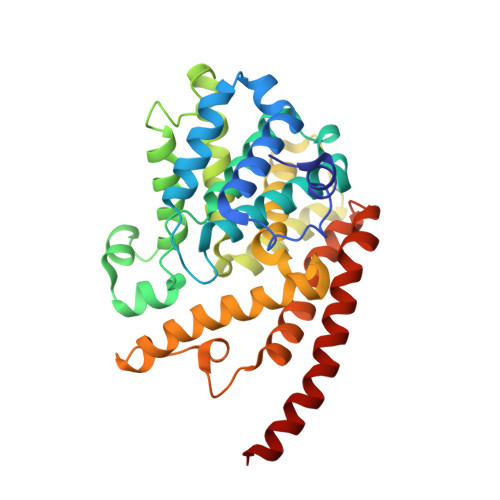Insight into Binding of Phosphodiesterase-9A Selective Inhibitors by Crystal Structures and Mutagenesis
Wang, H., Luo, X., Ye, M., Hou, J., Robinson, H., Ke, H.(2010) J Med Chem 53: 1726-1731
- PubMed: 20121115
- DOI: https://doi.org/10.1021/jm901519f
- Primary Citation of Related Structures:
3K3E, 3K3H - PubMed Abstract:
PDE9 inhibitors have been studied as therapeutics for treatment of cardiovascular diseases, diabetes, and neurodegenerative disorders. To illustrate the inhibitor selectivity, the crystal structures of the PDE9A catalytic domain in complex with the enantiomers of PDE9 inhibitor 1-(2-chlorophenyl)-6-(3,3,3-trifluoro-2-methylpropyl)-1H-pyrazolo[3,4-d]pyrimidine-4(5H)-one ((R)-BAY73-6691 or (S)-BAY73-6691, 1r or 1s) were determined and mutagenesis was performed. The structures showed that the fluoromethyl groups of 1r and 1s had different orientations while the other parts of the inhibitors commonly interacted with PDE9A. These differences may explain the slightly different affinity of 1r (IC(50) = 22 nM) and 1s (IC(50) = 88 nM). The mutagenesis experiments revealed that contribution of the binding residues to the inhibitor sensitivity varies dramatically, from few-fold to 3 orders of magnitude. On the basis of the crystal structures, a hypothesized compound that simulates the recently published PDE9 inhibitors was modeled to provide insight into the inhibitor selectivity.
Organizational Affiliation:
Department of Biochemistry and Biophysics and Lineberger Comprehensive Cancer Center, The University of North Carolina, Chapel Hill, North Carolina 27599-7260, USA.

















